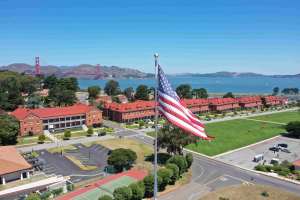Presidio Volunteers Help Restore Spring's Historic Channel
Volunteers will help excavate the El Polín Spring’s historic cobblestone channels

Presidio of San Francisco (June 15, 2011) — Part of the spring that once quenched the thirst of the Presidio’s earliest settlers will be unearthed this weekend when the Presidio Trust hosts the first of four Community Archaeology Digs this Saturday, June 18 at 10 am at El Polín Spring.
Volunteers will help excavate the spring’s historic cobblestone channels, originally built in the late 1930s as part of a Works Progress Administration effort during the depression. The sessions will include talks on the history of El Polín and archaeological instruction including excavation techniques, artifact identification, and site documentation.
“The response we’ve gotten has been tremendous,” says Kari Jones an archaeologist with the Trust. “People are really into fieldwork and the process of discovery. These days are a great, hands-on way to foster a sense of stewardship and to deepen their connection to the park and to El Polín in particular.”
One of San Francisco’s most unique landscapes, El Polín Spring is the heart of the Presidio’s largest watershed, Tennessee Hollow. A quiet enclave, tucked away in an urban neighborhood, it is one of the park’s most cherished spots — an environmental treasure where history and nature converge. The only named spring in the Presidio, El Polín provides a habitat for both resident and migratory birds, as well as other wildlife. Its rich past encompasses Native American, Spanish-colonial, and Mexican and United States history. And more recently it has proven to be fertile ground for archaeological discovery. It was here in 2003, archaeologists uncovered the first known colonial residence in San Francisco outside of El Presidio. The adobe structure is believed to have been the home nearly 200 years ago of two prominent local families: the Briones and Miramontes.
Daylighting the spring is part of the transformation of El Polín into a focal point of outdoor education: a place to explore both history and nature. Asphalt will give way to a pedestrian trail and boardwalk. Recent archaeological discoveries will be interpreted, offering visitors a glimpse into the daily lives of the Presidio’s earliest residents. A picnic area, barbecue, benches, gathering places, restrooms, and other improvements will make the area more welcoming for visitors while preserving El Polín’s distinctive character. And, with the support of community volunteers, the process of habitat restoration — begun with the planting of a broad variety of native trees, grasses and plants — and archaeological discovery will continue for years to come.
Named for the 1st Tennessee Regiment, a group of volunteer soldiers who made camp in the low ground east of Funston Avenue prior to shipping out to the Philippines during the Spanish-American War at the end of the 19th century, Tennessee Hollow encompasses one-fifth of the Presidio and provides visitors a rare opportunity to experience an entire watershed — from springs to San Francisco Bay — in just an afternoon hike. Its springs once provided a year-round fresh water source for Native Americans and colonial settlers. Though mainly hidden beneath roadways and storm drains, those springs still flow, supporting a valuable wildlife habitat. Following the 1906 earthquake, the watershed served as temporary housing for displaced San Franciscans. Framed by historic Presidio neighborhoods, Tennessee Hollow today is home to more than 1,200 people, more than one-third of the park’s residential population.
The Presidio Trust was established by the United States Congress in 1996 to administer the Presidio of San Francisco, an urban national park site located at the base of the Golden Gate Bridge. The areas overseen by the Trust include expansive open space and spectacular views, a 300-acre historic forest, and rare and endangered plants and wildlife. The park is home to 13 distinctive plant communities featuring 280 native plant species, 16 of which are rare or endangered. Thousands of hours of volunteer work have restored many acres of natural resource habitat. The Presidio Native Plant Nursery grows 60,000 plants each year to make this restoration possible. 21st-Century “green” practices are employed in all building and landscape rehabilitation efforts.